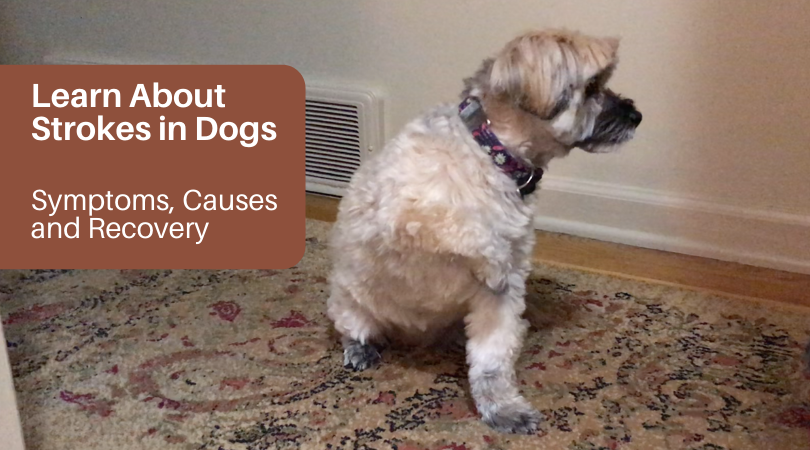Learn About Dog Stroke Symptoms, Types of Canine Strokes and Causes, and How to Help Your Dog Recover
This Christmas our dogs didn't get to open any gifts.
Before you get all upset, let me explain why - and don't worry - they are opening 1 gift starting today and then 1 every day until they are all opened!
On Friday evening one of our dogs, Tobie, lifted her paw and then listed over to the left. I was immediately next to her trying to figure out what was wrong with her paw or leg. Then as quickly as it started she was fine and acting normally.
Saturday morning and evening there were identical episodes that came and went as quickly as the one on Friday.
Sunday morning I was in the shower when Tobie came into the bathroom with one paw up and the gait of a drunken sailor. I did what all dog moms would do - naked and dripping wet, I ran into the other room and grabbed my phone to record video of the episode.
I sent the video to the canine neurologist that treated Piper through GME and confirmed it was likely a seizure.
Unfortunately, over the next few hours she had very little recovery time between episodes.
I knew from experience we needed to act urgently to control the seizures if we wanted the best possible outcome and for that, we needed to go immediately to the emergency room.
The ER quickly did bloodwork and started an intravenous loading dose of seizure medication - keeping her overnight for observation in the ICU.
The next day (Monday) she had a full neurological exam, chest x-ray and abdominal ultrasound by her canine neurologist.
The ultrasound revealed a suspicious looking nodule on her spleen but everything else looked good aside from a slight increase in some of the kidney values in her bloodwork.
Thankfully, she was able to come home Monday evening since she had stabilized and her neurologist felt it was reasonably safe.
Since none of the ER workup and neurological evaluation definitively revealed the cause of the seizures, the only other option remaining was to have an MRI. Without knowing the cause, it would be impossible to effectively treat her.
WIth the holiday, the next MRI scan day was Thursday which meant we had to make it through Christmas not knowing what was happening and keeping her as quiet and still as possible (which meant no tearing gifts open).
Christmas day was filled with worry as we considered the possible causes of the seizures - a brain tumor, GME, spinal cord injury or something else.
We diffused NeuroBalance twice a day and applied NeuroBoost topically daily to support Tobie’s neurological health.
The frequency of the seizures decreased but Tobie now had a constant head wobble and uneven (drunken sailor) gait all the time. It was really hard to watch my precious Tobie struggle and be completely helpless in providing any assistance other than to just keep her safe.
After a very low key and very emotionally difficult Christmas, Tobie had the MRI on Thursday.
The diagnosis: Tobie had a cerebellar stroke.
Her neurologist explained that until recently it was thought that strokes in dogs were very rare but with advances in veterinary neurology and the increased use of MRIs to determine the cause of seizures, strokes are being diagnosed more frequently in both dogs and cats.
What is a stroke?
A stroke occurs when a blood vessel is blocked or narrows so that blood and oxygen are no longer carried to the brain. The area of the brain lacking sufficient blood and oxygen becomes ischemic and is damaged. The symptoms will vary depending on the severity of the damage and the part of the brain affected.
What causes strokes in dogs?
Most strokes involve blood clots but some may be caused by tumors (cancer), bacteria, parasites, hypertension, heart disease, trauma, diseases like Cushings Disease (hyperadrenocorticism), clotting disorders, or hypothyroidism.
How can I tell if my dog has had a stroke?
The symptoms of stroke will depend on the stroke type, location and severity. In general, here are some of the signs you may see:
- Seizures
- Head tilt
- Head wobble
- Falling or listing to one side - loss of equilibrium
- Loss of balance
- Extensor posturing of the head and neck
- Bowel and/or bladder incontinence
- Changes in personality
- Less aware of surroundings (dazed or zoned out)
- Abnormal eye movement or positioning
- Blindness or other visual impairments
- Nausea/vomiting
Three Stroke Types
There are different types of a stroke:
Transient Ischemic Attack (called a TIA or ministroke) temporarily blocks blood flow to the brain. This type often does not result in permanent loss of function but should be seriously considered as a warning sign.
Ischemic strokes occur when a blood clot stops the blood from flowing to the brain. There are 2 types of ischemic stroke - one is when the blood clot forms where the blockage occurs and is referred to as a thrombotic stroke. The other type is an embolic stroke and occurs when a blood clot forms elsewhere in the body and travels to the brain.
Hemorrhagic stroke (or bleeding in the brain) occurs when a blood vessel in the brain ruptures or leaks spilling blood into the surrounding tissue. These are typically the most devastating strokes because blood is toxic to brain tissue and causes catastrophic damage in the area where a bleed occurs. All of the functions controlled by the damaged area of the brain are affected, often times permanently.
How to support your dog after a stroke
In Tobie's case, her neurologist suspects the stroke was a thrombolic ischemic type but we don't know the cause of the blood clot as her heart is healthy and she has no cardiac or vascular disease markers. We’re also still waiting for the final radiology report and interpretation of the MRI to be able to make more conclusive assumptions.
For now, the continued episodes are like the aftershocks following an earthquake and this activity is keeping her in a volatile place. We must keep her calm and quiet in order to reduce the aftershocks so her body can begin to heal. So, for the next two weeks Tobie is on very restricted activity while we anxiously await the final MRI report. Then we will re-do bloodwork to check for causes or clues as to why this happened. Once she is more medically stable, we can assess what functional limitations remain and possibly start therapy to help regain the function and mobility lost. After all of this, we still have to investigate the spleen nodule and make a determination as to whether it is malignant or benign. Tobie has a hard road ahead of her but she has the heart of a lion and will do everything she possibly can to return as close to normals as possible.
The good news is many dogs are able to recover after a stroke but it will take time, therapy and patience to regain what was lost.
For now, we are so blessed to have our little Tobie resting peacefully at home and on the road to recovery.
We will continue the essential oil support including LiverBoost, Any-Itis RTU and Calm-A-Mile Diffusion as part of her animal-safe essential oil therapies.
Give your 4-Legger a big hug today as we were so quickly reminded how dramatically circumstances can change. Tobie is not out of the woods yet and the next couple of weeks will be critical as we see how her neurological system settles. We never know what the day will bring, but we can choose how we respond. In Tobie’s case, our choice will be to provide the very best care and interventions that we possibly can to help her reach the highest functional outcome.





